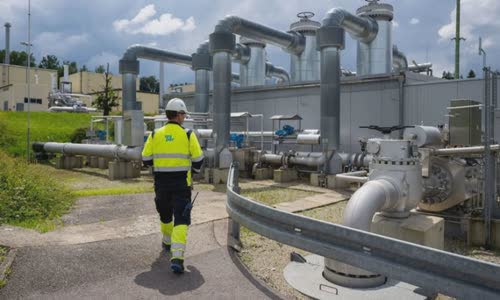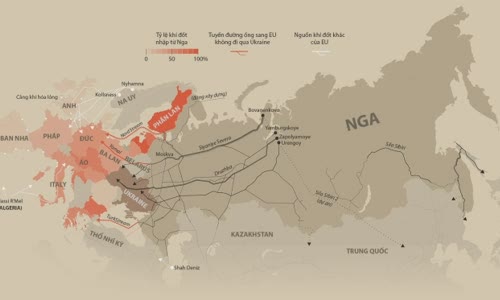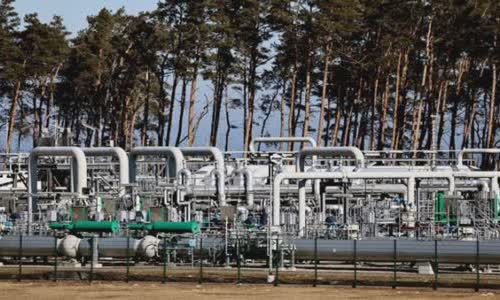The decision to reduce the Nord Stream 1 pipeline capacity is said to be a test from Moscow of Europe's stamina when lacking Russian gas.
The Russian Gazprom Energy Group announced that from July 27 will cut the amount of gas supply daily through Nord Stream 1 to Europe to 33 million cubic meters, equivalent to 20% of the pipe capacity.

Photo: AP.
The maximum gas transport capacity of Nord Stream 1 is more than 160 million cubic meters per day.
Nord Stream 1 each year transports about 55 billion cubic meters of gas to the European Union (EU).
A natural gas storage facility in Bierwang, Germany, last month.
However, European officials rejected the explanation from the Russian side, saying that Moscow was just wanting to weapon gas to burn to put pressure on the West.
Ursula Von der Leyen last week said that Russian President Vladimir Putin wanted to put pressure on us before this winter, when she proposed EU member countries immediately cut 15%.
This is the scenario that President Von Der Leyen mentioned in last week, her spokesman said on July 25.
President Putin last week announced that Russia would fulfill the commitment to supply gas to Europe, but warn the air flow through Nord Stream 1 may soon be limited if the sanctions from the West stopped from the West.
Because many European countries depend on the Russian gas flow transported through Germany, if the supply through the Nord Stream 1 pipe is unstable or exhausted, most of the continent will immediately feel its impact.
Russian gas transferred pipes for Europe.
If there is no sufficient gas in the winter months, when the need to heat up, European governments say they may be forced to allocate gas to the norm, which is given to the households.

Photo: B?m ?? xem chi ti?t
Analysts and officials warn that when this scenario occurs, Europe's economy is at risk of falling into a recession.
If the Nord Stream pipeline is completely locked and the upcoming winter becomes more harsh, the gas in Europe's reserves can be exhausted at the end of February.
When there was no abundant gas flow from Russia, the winter of 2023 in Europe was even worse, the market research and consulting firm Wood Mackenzie, the headquarters in the UK, predicted.
According to the International Energy Agency (IEA), although Russia's oil and gas exporters are selling less goods, Moscow's high energy price means that Moscow's revenue source is still increasing.
Since launching a military campaign in Ukraine in February, Russia's revenue from oil and gas exports to Europe has doubled compared to the average of recent years, to 95 billion USD.
The increase in Russia's energy revenue in the past 5 months is three times higher than what this country is collected when exporting gas to Europe in a winter.
With a large revenue, Russia can continue to prolong the war in Ukraine, with calculating that electric bills soared and the energy crisis can weaken the support of the European public with Ukraine, promoting one.
Based on what we have witnessed in the past year, it would be not wise to exclude the possibility that Russia abandoned revenue from gas exported to Europe to achieve political levers in Ukraine, IEA CEO.
President Putin claims that the gas stream through Nord Stream 1 will decline even if the turbine of the pipe sent to Canada to repair is not returned at the end of July, when another turbine will stop working for maintenance.
Our partners are trying to take responsibility for the mistakes they have made for Russia and Gazprom, but that is completely unfounded, the Kremlin boss emphasized.

Photo: Reuters.
To deal with the scenario, the EU has switched to using more expensive liquefied (LNG) gas, transported by ships from some countries like the US or Qatar.
Germany is speeding up the construction of imported ports on the North coast, but this process will take many years with a large funding.
However, LNG alone will not compensate for the deficiency of Europe's gas.
The land facility of Nord Stream 1 gas pipeline in Lubmin, Germany, in March.
LNG export facilities of the world are operating at full capacity, in the context of scarce global energy supply.
Saving and looking for other fuel sources is still considered by Europe as the key to problem solving.
Countries are racing to ensure the supply of energy instead, with the leaders of Italian, France and the EU signed a number of agreements with their partners in Algeria, Azerbaijan and the Unified Arab kingdoms.
However, IEA still recommends European countries to enhance the mobilization of people to save energy at home as much as possible and plan to share gas in case of emergency.
European leaders need to prepare for this possibility right now to avoid possible losses due to the lack of synchronous reactions in the winter, Birol said.



 Malcolm Glover
Malcolm Glover







